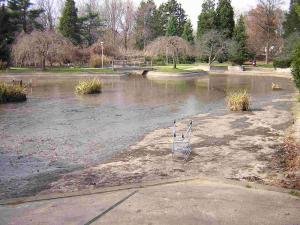Montgomery County has installed two cool new “green” features that are designed to enhance the ecological health of Sligo Creek Park.

Montgomery County has installed two cool new “green” features that are designed to enhance the ecological health of Sligo Creek Park. In the headwaters portion of Creek, at the Kemp Mill pond on Arcola Avenue, “floating wetlands” were installed to reduce the amount of nutrients in the pond and to provide some beautification. Excessive nutrients — especially nitrogen and phosphorous — are one of the biggest environmental problems facing our local streams and rivers, as well as Chesapeake Bay. The Kemp Mill pond has long had an excess nutrient problem because of the unnaturally large goose and duck population at the pond. See earlier postings about the pond. The “floating wetlands” contain materials and root systems that soak up these excess nutrients from the pond. The wetlands are modular mats made of fiber from the outer husk of the coconut, called coir, into which plants are inserted. Many plant species thrive in these artificial wetlands, including those chosen for this project: hibiscus, decodon, and justicia. These plants also increase habitat diversity.
A second new “green” feature is located along Dennis Avenue, where the county’s Department of Environmental Protection (DEP), in coordination with the Parks, is installing “bioretention gardens” as part of the county’s Dennis Avenue green streets initiative. The project was funded by DEP and the county’s Department of Transportation. These installations work by diverting hot polluted stormwater runoff from Dennis Avenue and directing it to the bioretention gardens. When completed, these installations will become beautiful green spaces that also protect Sligo Creek. The gardens use a special soil mix that allows runoff from Dennis Avenue to easily soak in. The soil is full of roots and microbes that break down pollutants like petroleum products that leak from cars. The native plants also soak up water and nutrients through their deep roots. The runoff is then stored in a bed of gravel so it can slowly soak into the soil and gradually enters into Sligo Creek as cool, clean water. If there is so much rain that the gravel storage is full of water, perforated pipes beneath the soil mix, but on top of the gravel bed, collect the rain water and pipe it to the storm drains and into Sligo Creek.
These are but two small efforts in the much larger, long-term project to clean up Sligo Creek. Montgomery County officials stress that they cannot fully restore Sligo Creek without the help of the communities located alongside it. This will take joint efforts by local and state governments, homeowners, businesses, and institutions all working together to achieve our goals. You can help us restore Sligo Creek by learning how to manage stormwater on your own property and by supporting Friends of Sligo Creek. Visit us on our homepage (you can also click on the join the listserv button on the right side of our homepage to get added to our listserv) or “like” us on Facebook.
Ed Murtagh is actively involved with stormwater outreach and education efforts with Friends of Sligo Creek and Neighbors of the Northwest Branch.


